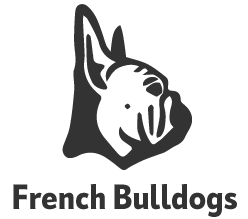Look-a-Likes" (also forbidden colors) don't have a recognized pedigrees!
Please note: *Look-a-likes* (mongrels/crossbreeds) are sold that piggyback on the name *French Bulldog* these dogs obviously do NOT have a globally recognized FCI pedigree.
These mongrels resemble hunting dogs with standing ears and the same long nose and some also have a long tail, but you also have *Look-a-likes* that resemble a French Bulldog but wear prohibited colors because they may cause health problems.
These are bred from crosses and do not have an official FCI pedigree but an unrecognized pedigree that is for sale everywhere!
A “look-a-like” (crossbreed) is a dog that may resemble a purebred dog without a recognized pedigree
A dog without a pedigree is not a purebred dog. A dog without a pedigree can resemble a purebred dog. But because you don’t know how, where, why and what was bred into it, we call it a “look-a-like”. Of course, a mongrel or a dog that resembles a purebred dog can be just as sweet as a purebred dog, and of course a pedigree says nothing about the fun you can have with your dog. But a pedigree does say something about whether the dog has been bred with care.
These breeders and puppy mills., most of whom (not all) are registered with the Chamber of Commerce because much is tax deductible, have the best stories on the internet in the hope that many people will fall for it. They don’t want to import fresh blood because that costs too much money and crossbreeding quickly earns a lot of money!
Also very important to read!!!
A French Bulldog cannot genetically have a long tail because the tail was bred out a long time ago. There is a Feragen laboratory with which I have had email contact and they do breed testing, but indicate that they can only look back up to three generations, so if the same breed had been used for 3 generations, the outcome would be a purebred dog, but they also clearly indicate that they do not know what kind of dogs were used for the three generations. I have also contacted all other laboratories and they indicate that a breed test is impossible and unreliable!
“Look-a-likes” determine research outcomes
Some breeds have relatively many “look-a-likes”; with other breeds this is less. We also see this in the results of scientific research conducted into the health of purebred dogs.
For example, the study ‘Incidence of harmful breed characteristics and hereditary defects in companion animal populations’, which was recently commissioned by the Ministry of Economic Affairs (and for which more dog breeds will be studied in the future), showed that a large proportion of the investigated dogs was not a purebred dog at all. Almost all dogs examined in this study were “look-a-likes”.
In the first part of this study, three breeds were examined, namely the Chihuahua, the French Bulldog and the Labrador Retriever. Of the Labradors examined, only twenty percent had a pedigree, of the French Bulldog this was twelve percent and of the Chihuahuas this was an overwhelmingly low six percent. To be clear: with Chihuahuas this means that 94 percent of the dogs examined are a “look-a-like”. A dog that has been bred without any requirements being placed on its parents in terms of health, well-being and social behavior. This large group of “look-alikes” therefore determines the image that emerges from the research.
Please note: The only worldwide recognized pedigrees are (FCI, AKC (AMERICA) and UNITED KENNELCLUB (ENGLAND)
Not recognized FCI colors (AKC allowed in America)
It is important that potential puppy buyers understand that dogs of disqualifying color do occur from time to time, but breeders who breed to the breed standard do not deliberately set out to produce them. They may be the result of recessive traits that only emerge when puppies inherit a recessive gene from each parent or be traits that go back to earlier ancestors. Regardless of the mode of inheritance, out of respect for our breed standard, puppies and dogs that exhibit or carry disqualifying traits should be spayed or neutered and serve as companion animals as valuable as other companion animals but no more valuable financially.
Which colors cause health problems for the French Bulldog:
Color Merle: (bred through crossbreeding)
One of the most common problems is genetic malformations. Because this dog has a unique genetic condition, it can lead to stunted limbs, blindness or deafness. Numerous Merle French bulldogs also suffer from allergies, immune disorders, heart murmurs and hip dysplasia and do not grow old. Also keep in mind that because they have such light-colored eyes, they may have eye defects. Some of the common problems include one eye being larger than the other, one eye being covered with a nictitating membrane, cataracts and coloboma (a congenital condition that causes a hole in the iris of the eye)
Color Blue or Mouse Gray (all variants such as blue-brindle, blue-pied, blue-fawn, etc.)
Blue is a dilution of black (weak color) and can lead to scabies, alopecia, immune disorders, neurological disorders, allergies, heart disease and cataracts.
Color White: Can carry the deaf gene.
Other colors that are considered rare in French Bulldogs are the black/tan color like a Doberman (black & Tan) and the black completely without a trace of brindle. These colors are so dominant that when breeding they outshine all other colors in the bloodline. It would indeed be sad to lose healthy Fawns, brindles, creams, etc. because a handful of unethical and uneducated people wanted blacks and black and brown.
The blue color is the biggest trend of all for French people. They are bred and sold so quickly that there are waiting lists for the puppies. Blues (colored like a Weimaraner) are more of a problem with the breed than any other fad color. This color tends to produce yellow or green eyes, which, as mentioned above, can lead to blindness.
A blue French bulldog.
This color carries a genetic condition that causes dry, flaky skin and hair loss. Although this will not be obvious in a puppy, problems will develop as the dog gets older. Healthy dogs live longer and cause less stress. Setting yourself up for a lifetime of heartache at your beloved pup’s expense isn’t worth a designer’s suit or a trending fad.
Do your research before purchasing a dog of a particular breed. Sacrificing your pet’s future health, or contributing to the eventual decline of your favorite breed, isn’t worth bragging about if you have a rare dog. These are living beings who suffer from our stupidity – not a handbag that we throw away when it gets worn out. Be a responsible owner and enjoy your dog’s long healthy years.
Since February 1, 2016, French Bulldogs with the unrecognized colors blue, Blue Merle, Chocolate Brown and Black & Tan can no longer be used for breeding. There is a suspicion that these colors cause health problems.
This means that these unrecognized colors can still appear in pedigrees published before February 1, 2016.
Previously, these prohibited colors received a NEK (unrecognized color) entry on the pedigree and were still allowed to be bred with.
Why are these French Bulldog colors bred?
Unfortunately, as with any popular dog breed, it has been found that the consumer has the supply. The more interest there is in these so-called “rare” of “distinctive” colors, the greater the supply will ultimately be. Breeders who only breed for financial closures will continue to meet this demand. Unfortunately, this also complicates the dangerous health problems for the animal.
A Merle, Blue, Black & Tan or chocolate French Bulldog are not rare. This is often told to the future owner, but nothing could be further from the truth. The reason for the scarcity of this color lies in the fact that they are banned and, as it were, blacklisted. Breeders who follow the guidelines of the breed standard will never breed litters where there is a chance of these color nuances. In this way she keeps the breed healthy and the animal is recognized by the official breed club and receives an FCI pedigree.
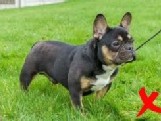
Black & Tan
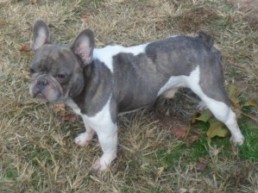
(blue pied brindle)

(Blue/Gray/Mouse color)

(Blue & Tan)

(Blue Fawn)
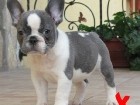
(Blue pied)

(Choco/Pied)

(Blue/Fawn/Mouse color)
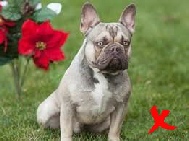
(Choco/Fawn)

Lilac/Tan

(Blue Brindle)
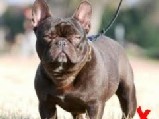
(Chocolate)
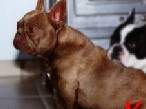
(Choco/Lever)
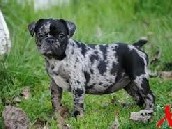
Merle

Lilac
